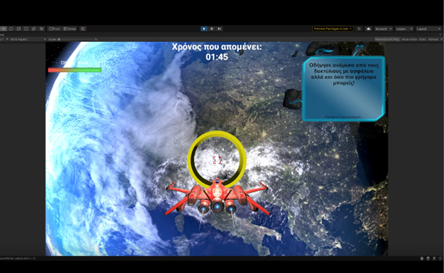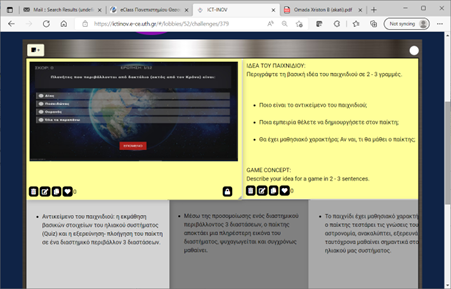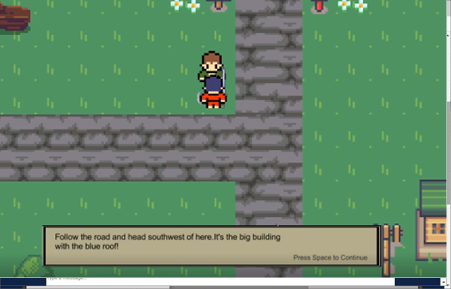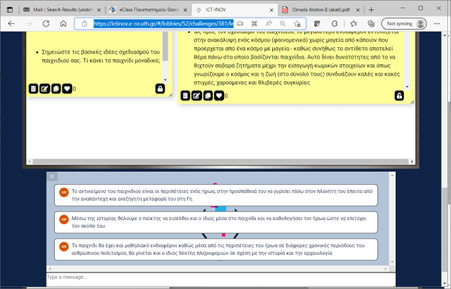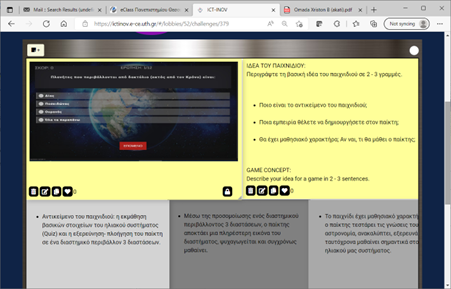
Description of the course
The course focuses on the design and implementation of games and serious games. Given its focus on serious games, namely games implemented for learning purposes, the course further integrates aspects of pedagogical design, such as active, experiential, collaborative, and game-based learning. The course offers a theoretical and a practical component. In the theoretical component, students focus on all aspects of game design, starting from the understanding of the principle of serious games, game terms, and game genres and continuing to game design activities such as world design, character design, story design, game balancing, characteristics of on-line games, puzzle design, level design, tactical game design, and more. In addition, the theoretical aspect of the course covers areas such as the use of serious games in diverse contexts, including education, marketing, health, and awareness raising on social issues such as engaging in civic life, preserving the environment, and more. In the practical component of the course, students develop a game in teams. They have the option of developing a digital prototype of their game using popular platforms, such as UNITY® and Scratch® or a board game designed with paper.
Description of the participants
The course is an elective in the Master’s program on Applied Informatics. The program targets professionals that wish to obtain a degree related to Computer Science. It has a duration of 2 years. In the 2021 – 2022 academic year it was attended by 15 students out of the 17 enrolled in the Master’s program, demonstrating that the course is very well received.
Description of gamified design thinking activities
A learning activity based on design thinking was specifically designed for the course. The objective of the learning activity was to challenge students to design a game and to implement a prototype, either digital or physical. Students had the option to design a game that addresses the needs of a target group of their choice, such as primary or secondary school learners, higher education students, professionals, disadvantaged individuals, or other. In addition, students had the choice of designing a game of any genre, such as an arcade game, an adventure game, or an escape room. The course took place mostly virtually. The ICT-INOV platform proved to be a great team collaboration tool when team members were not in the same room.
Students worked in 6 groups of up to 3 individuals. The activity was structured as follows:
Step 1: Game concept.
Students were encouraged design a game concept addressing the following aspects: game objectives, user experience, learning focus of the game, basic aspects of game world design, elements of story design, user interaction models, and marketing plans.
Step 2: User analysis.
Students were challenged to describe a characteristic user or player by considering aspects such as what is the target audience, what is the age of the audience, what characteristics differentiate the target audience from other groups, and what challenges the audience likes. They were further encouraged to describe a typical player by describing the “user’s journey”, namely the experiences of the user throughout her life that make her the person that she is today, for example experiences in school, university, workplace, family, and more. Also, students were exposed to other tools for user analysis, such as the empathy map.
Step 3: Game mechanics.
Students were instructed to describe the core game mechanics, including physics rules, progression mechanics, game economy for trading resources, social dimension, tactical elements, game objects and attributes, relationships between game objects, sources and drains of resources, and more.
Step 4: Game world design.
Students were asked to design the game world, including the physical dimension, time elements such as day and night or seasons, people, values, social organization, emotional dimension, ethical dimension, style, mood, aesthetics, style, mood, dimensions, whether it is located inside a building or outdoors.
Step 5: Story design.
Students were challenged to introduce a story into the game by applying the Hero’s Journey model, in which story follows the hero in the ordinary world, his exposure to the challenge, refusal of the hero to face the challenge, meeting a mentor, accepting the challenge, trials, enemies, allies, reaching the largest conflict of the story, reward, and the road back.
Step 6: Character design.
Students were challenged to describe the main characters of the game. They were further asked to describe if the characters would be art- or story-based, the looks of the characters, and the behaviour. They were encouraged to introduce an avatar into the game and consider how the avatar would grow through the challenges and story.
Steo 7: Outline of final game design.
Students were encouraged to present a summary of all design elements of their game, which is a synthesis of the ideas analysed in previous steps.
Following are examples of project implemented by students:
- An educational escape room. A game that challenges the player to solve puzzles to leave a closed space.
- A world trivia game. A knowledge game that challenges players to answer questions related to geography.
- A driving rules game. A game that helps players understand street signs.
- A space game. The game has 2 gameplay modes. In the first, the player answers questions building general knowledge. In the second, the player drives a spaceship following rules of arcade games.
- A history game. An arcade game that exposes the player to history questions.
